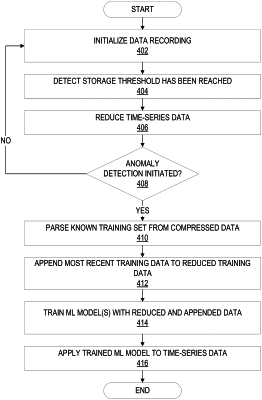| CPC G05B 23/0283 (2013.01) [G06F 11/3409 (2013.01); G06F 16/215 (2019.01); G06F 18/2148 (2023.01); G06N 20/00 (2019.01)] | 20 Claims |

|
1. A method comprising:
receiving a first time-series dataset that tracks at least one metric value over time;
generating a second time-series dataset that includes a reduced version of a first portion of the first time-series dataset and a non-reduced version of a second portion of the first time-series dataset, wherein the second portion of the first time-series dataset includes metric values that are more recent than the first portion of the first time-series dataset;
determining one or more virtual metrics for the first portion of the first time-series dataset based on a non-reduced version of the first portion of the first time-series dataset, wherein the one or more virtual metrics are not discernable from the reduced version of the first portion of the first time-series dataset; and
training at least one machine learning model using the second time-series dataset that includes the reduced version of the first portion of the first time-series dataset and the non-reduced version of the second portion of the first time-series dataset.
|